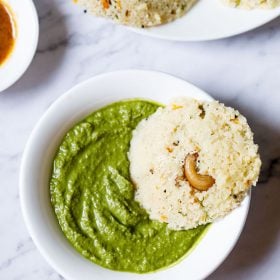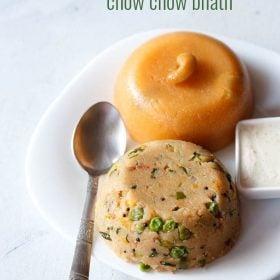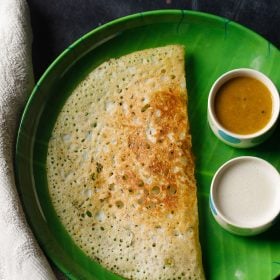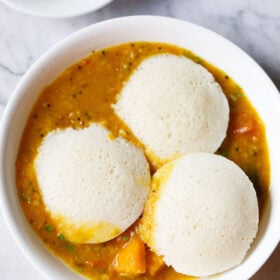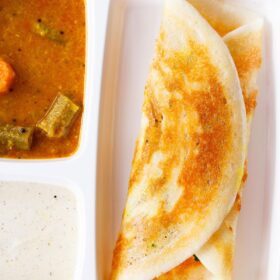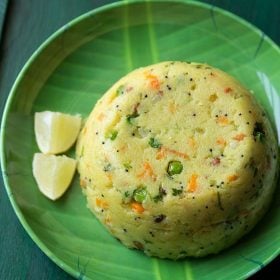On the looks of it, you might would want to call this dish as an Upma, but let me tell you it is a Rava Kichadi which is different than its South Indian counterpart. Most of the ingredients that go into making this kichadi are also same as the upma. But I would still say that the kichadi is quite distinct in its nature. This kichadi made from rava or sooji is a usual breakfast dish made at our home as well as the whole of South India.

About Rava Kichadi
Isn’t it obvious that if 2 dishes have a different name (even if they belong to a similar cuisine), they will be somehow different no matter how closely they are related? The same happens with a Rava Kichadi and its close relative upma.
One of the most striking differences between the two is that while upma is quite humble, the way the ingredients are used in its preparation, the Rava Kichadi is richer and more indulgent with the generous use of ghee (clarified butter) and sometimes cashews added to it too.
In my recipe of Rava Kichadi, I have also added some vegetables to bring in an element of added texture and nutrition. On the other hand, a classic upma will not have veggies in it. Although, many recipes in different households may add vegetables in an upma too. Same for the cashews too.
Other than these, the ingredients that make a Rava Kichadi are almost all those that also make up an upma. These are lentils (chana dal and urad dal), mustard seeds, curry leaves, ginger, green chilies, onions and turmeric powder. While a little sugar can also be added in an upma, a traditional Rava Kichadi will never have it.
Upmas, like the ones available on the streets of Mumbai, Maharashtra often serve them with a topping of sev (fried gram flour vermicelli). But a Rava Kichadi is essentially never served like this. Although, again, one can always modify as per their personal preferences.
More On My Recipe
Rava Kichadi is more like a khichdi, which is made with sooji or rava and not rice and lentils. So, you can also call this preparation as a sooji khichdi. It is definitely a famous breakfast option across South India.
As I mentioned earlier, I like to add some veggies in the Rava Kichadi for an enhanced mouth-feel and nutrition profile. The veggies that can be added to this dish are capsicum (Shimla mirch or bell pepper), French beans, green peas (matar) and carrots (gajar). However, you can skip these and make it without veggies also.
Primarily, fried or roasted cashews also are added as a part of garnish in the Rava Kichadi. This also makes this dish richer than the upma. I have not mentioned the cashew bit in this recipe, but even I do add them as everyone is a fan of the flavor it imparts to the kichadi, as a whole.
Serve Rava Kichadi accompanied with some lemon wedges and coconut chutney. While serving only, you can add some roasted or fried cashews.
How to make Rava Kichadi
Roast Rava
1. Heat a pan or kadai (wok) and add 1 cup fine rava (sooji or cream of wheat) to it. Keep the heat on low while roasting rava.
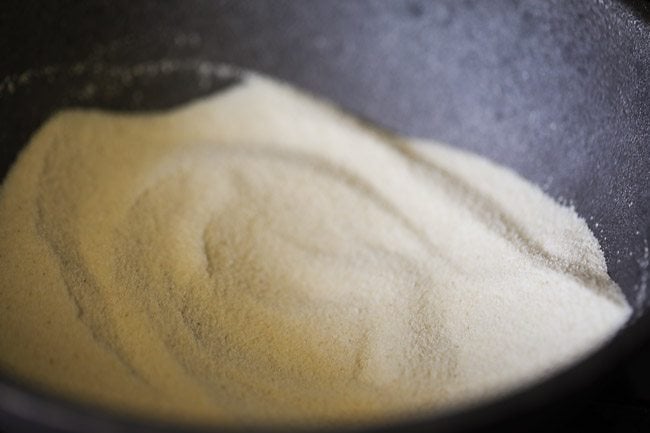
2. Stir often, while roasting the rava.

3. When the rava granules change color and you get a nice aroma, switch off the heat.
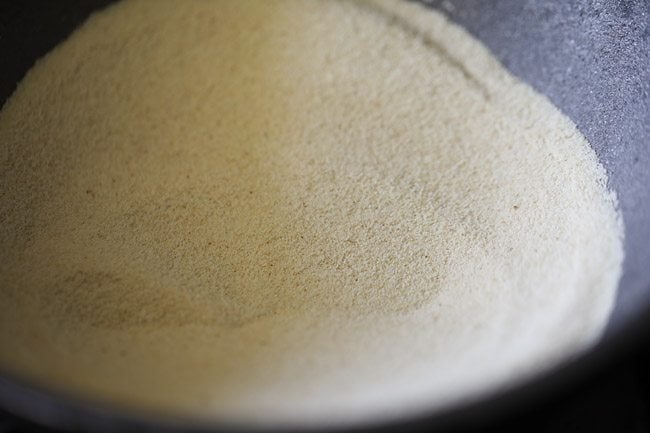
4. Remove the roasted rava on a plate. Keep aside.
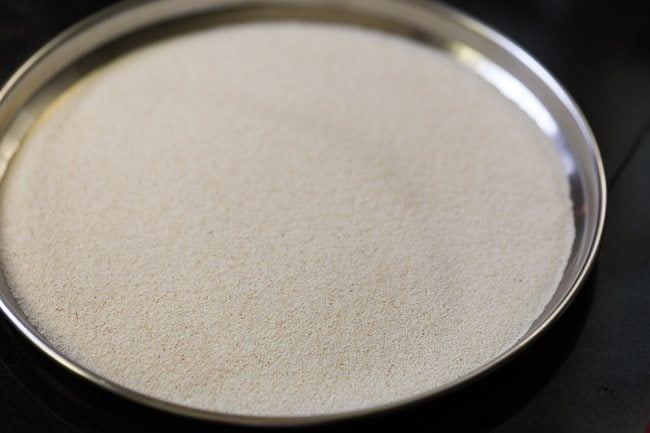
Make Vegetable Mixture
5. In the same pan or kadai, add 3 tablespoons ghee. Keep heat to low or medium-low.

6. Let the ghee become hot.
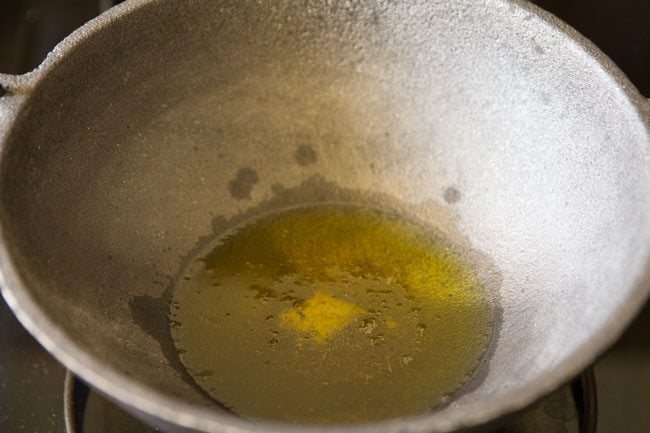
7. Once the ghee becomes hot, add 1 teaspoon mustard seeds.

8. Let the mustard seeds splutter.

9. When the mustard seeds begin to splutter, add 1 teaspoon chana dal and 1 teaspoon urad dal.
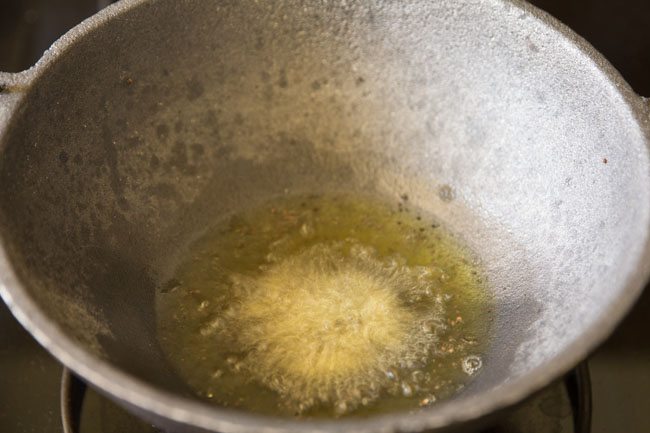
10. On low heat, fry the lentils until golden. Make sure not to burn them.

11. Then, add ⅓ cup chopped onions.
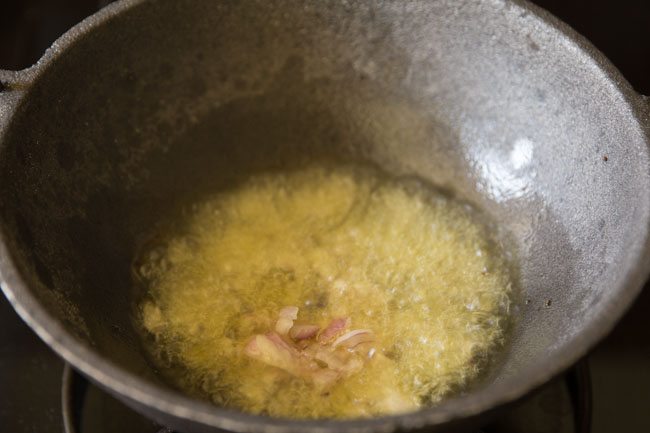
12. Sauté onions till translucent.
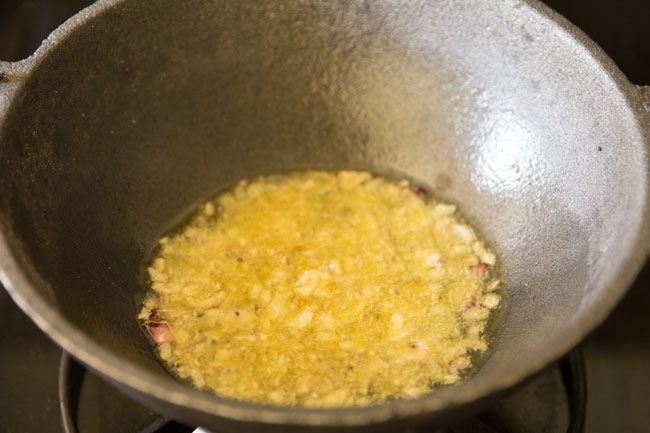
13. Next, add 1 or 2 chopped green chilies, ½ teaspoon finely chopped ginger and 8 to 9 chopped curry leaves.

14. Stir and mix.
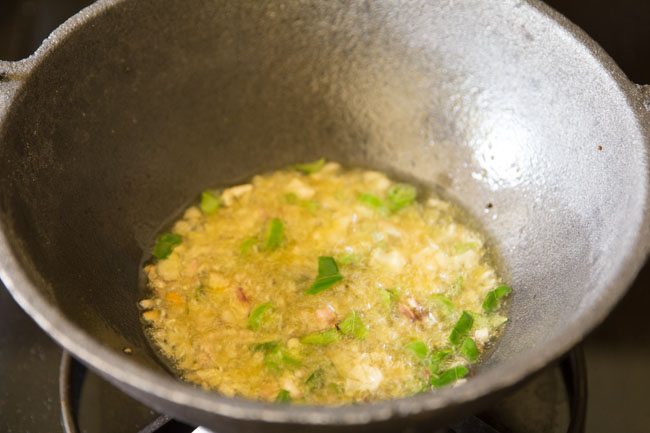
15. Then, add ¼ cup finely chopped carrots (¼ cup grated carrots), ¼ cup green peas (fresh or frozen) and ½ cup finely chopped tomatoes. Mix and stir.
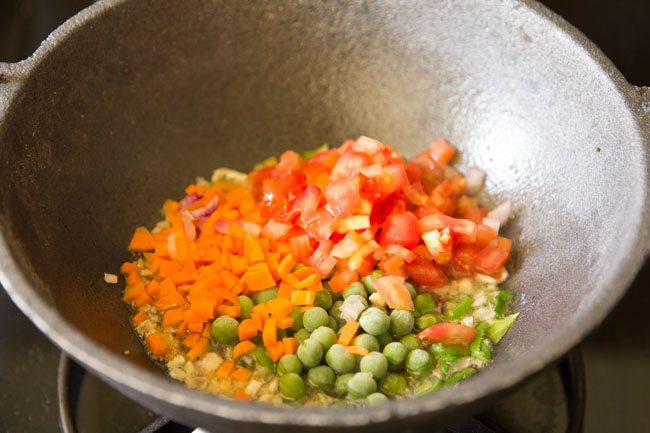
16. Next, add ¼ teaspoon turmeric powder.

17. Mix again and sauté for 3 to 4 minutes on low heat.

18. Then, pour 3 cups water.
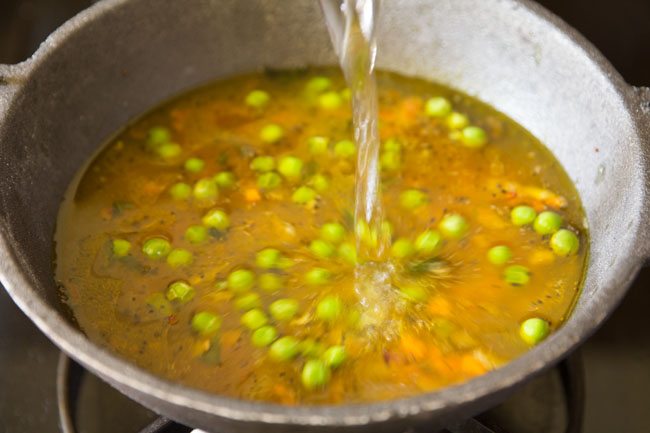
19. Add salt as per taste.
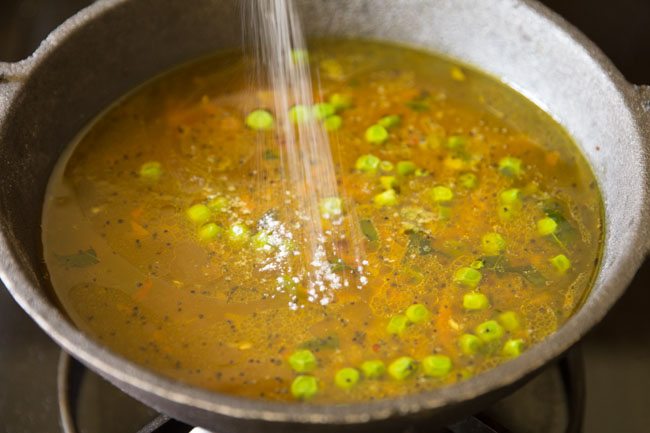
20. Increase the heat and let the water come to a rolling boil.

21. Once the water comes to a boil, then reduce the heat.
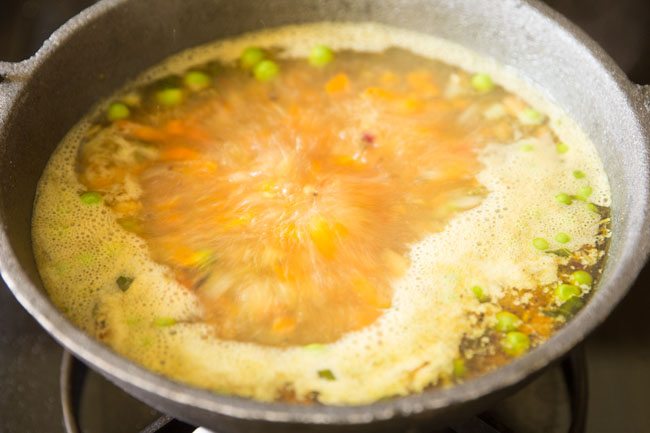
Make Rava Kichadi
22. Add the roasted rava in portions.

23. As soon as you add a batch of roasted rava, mix very well. So that lumps are not formed.

24. Add another batch of rava. Mix again.

25. This way add the rava in 3 to 4 portions or batches and mix thoroughly.
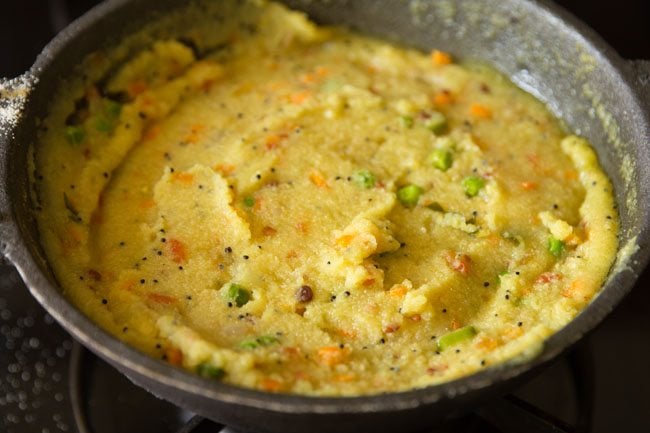
26. Cover the pan with a lid and steam on low heat for about 2 to 3 minutes.

27. Once done, remove the lid.
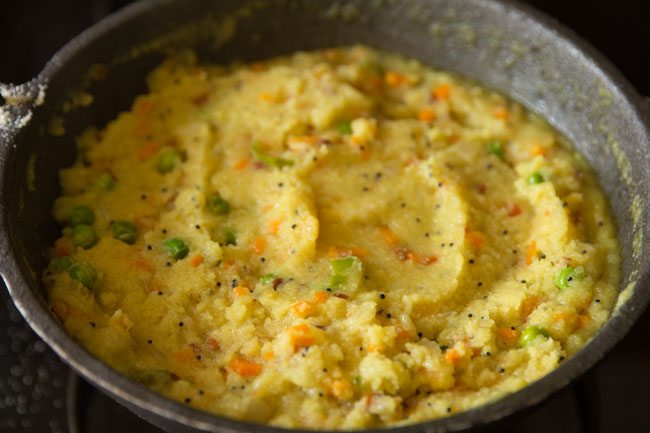
28. Add 2 tablespoons chopped coriander leaves. Mix very well.
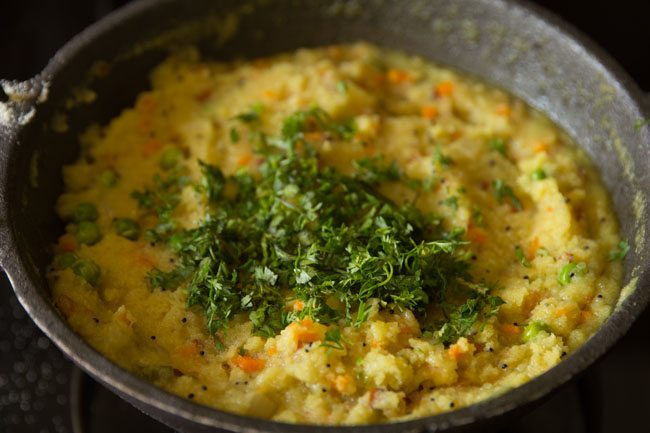
29. Serve Rava Kichadi accompanied with some lemon wedges and coconut chutney. While serving, you can also add some roasted or fried cashews.
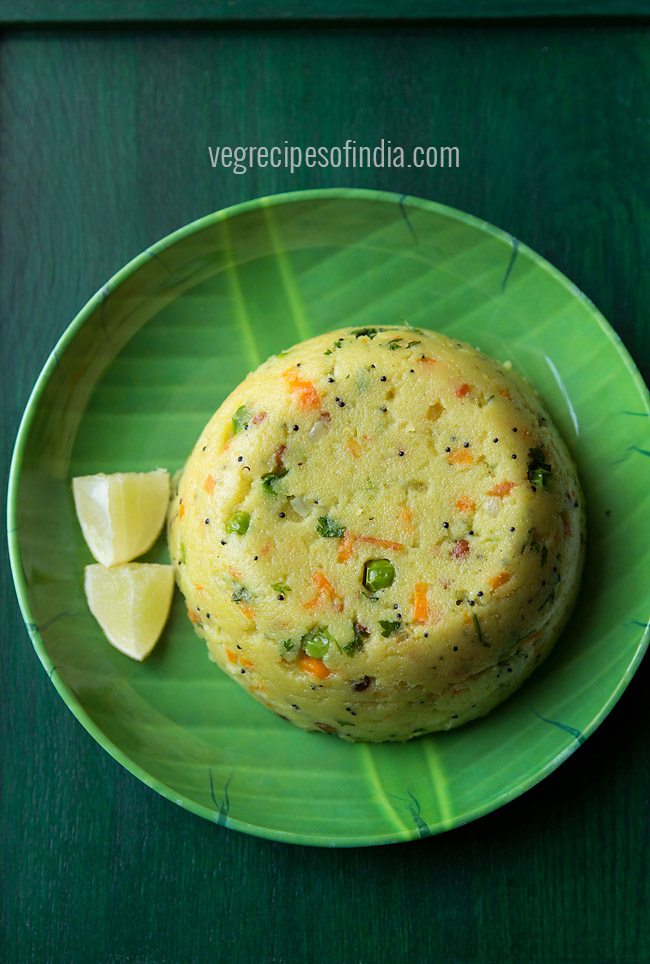
Expert Tips
- Make sure to use the fine variety of rava (cream of wheat) for this dish and roast it evenly. Keep stirring while roasting, till the color of the rava changes and it is nicely fragrant.
- You have to add the roasted rava in batches. After every batch you add, ensure mixing it well so that lumps are not formed.
- The choice of fat for this Rava Kichadi is ghee, for best results. But in case you’re not that big a fan of ghee or want to make a lesser rich version of the same, then use oil. You can use coconut oil, peanut oil, sunflower oil or any neutral tasting oil for this. With oil, the dish will also become vegan.
- You can add your choice of vegetables in this kichadi.
- For a soft, melt-in-mouth kichadi, the proportion for rava to water should be 1:3.
- If you have leftover kichadi, store it in the refrigerator and consume within 1 to 2 days. While serving, just reheat by sprinkling some water on it.
More Rava Breakfast Recipes To Try!
Breakfast Recipes
Breakfast Recipes
Breakfast Recipes
Breakfast Recipes
Please be sure to rate the recipe in the recipe card or leave a comment below if you have made it. For more vegetarian inspirations, Sign Up for my emails or follow me on Instagram, Youtube, Facebook, Pinterest or Twitter.
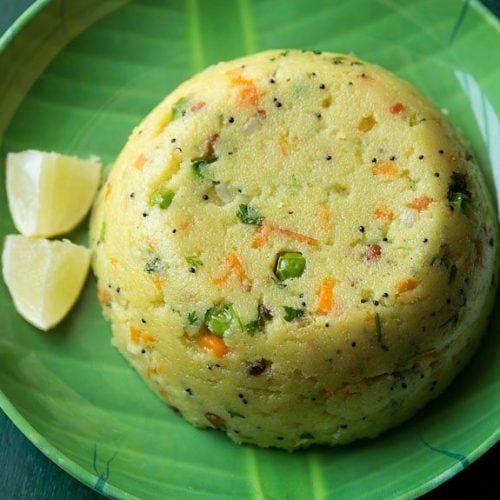
Rava Kichadi
Ingredients
- 1 cup rava – 150 grams, fine textured (sooji or cream of wheat or semolina flour)
- 3 tablespoons Ghee
- 1 teaspoon mustard seeds
- 1 teaspoon chana dal (split and husked bengal gram)
- 1 teaspoon urad dal (split and husked black gram)
- ⅓ cup chopped onions
- 1 or 2 green chilies – chopped or ½ to 1 teaspoon chopped green chillies
- ½ teaspoon finely chopped ginger
- 8 to 9 curry leaves – chopped
- ¼ cup finely chopped carrots or grated carrots
- ¼ cup green peas – fresh or frozen
- ½ cup finely chopped tomatoes
- ¼ teaspoon turmeric powder
- 2 tablespoons coriander leaves
- 3 cups water
- salt as required
Instructions
Roasting rava
- Heat a pan or wok or kadai and then add rava to it.
- Keep the heat to a low while roasting rava.
- Stir often when the rava is being roasted.
- When the rava granules change their color and you get a nice aroma from the rava, then switch off the heat.
- Remove the roasted rava in a plate. Keep aside.
Making rava kichadi
- In the same pan or kadai, add 3 tablespoons ghee. Keep the heat to a low or medium-low.
- Once the ghee becomes hot, add mustard seeds and let them splutter.
- When the mustard seeds begin to splutter, add chana dal and urad dal.
- On a low heat, fry till the lentils become golden. Make sure not to burn the lentils.
- Then add finely chopped onions. Sauté till the onions turn translucent.
- Next add chopped green chillies, finely chopped ginger and chopped curry leaves.
- Stir and mix.
- Add finely chopped carrots, green peas and finely chopped tomatoes. Mix to combine.
- Then add turmeric powder.
- Mix again and saute for 3 to 4 minutes on low heat.
- Then pour 3 cups water. Add salt as per taste.
- Increase the heat and let the water come to a rolling boil.
- Once the water comes to a boil, then reduce the heat and add the rava in batches.
- As soon as you add a batch of roasted rava, mix very well. So that lumps are not formed.
- Add another batch of rava. Mix again.
- This way add the rava in 3 to 4 batches and mix very well.
- Cover the pan with a lid and on low heat, steam the rava kichadi for about 2 to 3 minutes.
- Once done then remove the lid and add 2 tablespoons chopped coriander leaves. Mix very well.
- Serve Rava Kichadi accompanied with some lemon wedges and coconut chutney. While serving, you can also add some roasted or fried cashews.
Notes
- Remember to roast the rava very well. The rava granules should look crisp, separate and have a fragrant aroma when roasted properly.
- Use the finer textured rava to make the kichadi. You can also use bombay rava.
- You could even make the recipe without adding any vegetables. For the veggies, feel free to add your preferred vegetables.
- For a spicier kichadi, increase the amount of green chillies and add some more ginger if you prefer.
- You can easily scale up this recipe to make for larger servings.
Nutrition Info (Approximate Values)
This Rava Kichadi recipe post from the archives, first published on March 2017 has been republished and updated on November 2022.
